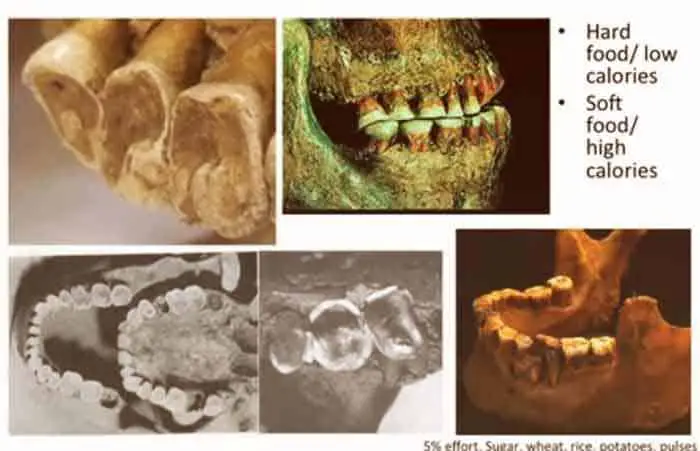
Most people chew gum to freshen their breath. Experts recommend chewing sugarless gum to improve your concentration and to promote saliva production. But by chewing, could you be making your face more chiseled?
Chewing gum can improve your jawline. The elasticity of gum works the muscles in your face and neck, making them more toned and strong. In the process, you get a chiseled jawline and also lose your double chin. It also promotes blood flow throughout the face making you look less bloated.
This article will explain how chewing gum improves the jawline, dangers associated with chewing gum, and what type of chewing gum is best.
How Does Chewing Gum Chisel Your Jawline?
According to dentists, you can get stronger jaw muscles by exercising them with gum chewing. You should also consider eating hard foods like sugarcane every so often.
The jaw has muscles like every other part of your body. There are two jaw-opening and three jaw-closing muscles. These muscles are attached to the face and neck. The jaw-closing muscles include the temporalis, masseter, and medial pterygoid, but to open the jaw, you use the digastric and lateral pterygoid muscles.
Since the jaw works like a motor with the muscles moving in a three-dimensional movement, it is important to exercise the muscular fibers of each. During any chewing activity, the jaw moves in a rotating manner. Chewing gum offers resistance to these muscles causing them to become stronger, resulting in a toned jawline. The circular motion means all the muscles are used when you chew.
You may notice that if you chew too much, you will get pain in the neck, cheek, jaw, and even sometimes a headache. This is because the muscles have been overworked. To avoid this, make sure that you chew for only 20 minutes a day and take a break. To begin with, you can chew for as little as 10 minutes a day.

Studies on Gum Chewing
A study by Ingervall et al. (1987) took a look at 13 children that had long faces. They had the children chew gum for one year.
The study found that the children who chewed gum had a stronger bite force and anterior mandibular rotation of 2 to 3.5 degrees. This means their jaws outwards and became more prominent.
A study by Sondang et al. (2003) showed that a stronger bite is correlated with a better gonial angle, a longer ramus, and larger maxilla. It implied that people with longer faces tend to have a weak bite force.
This study is consistent with what we know about orthotropics and mewing. Chewing gum while maintaining proper oral posture leads to better forward growth, a more prominent jawline, a better gonial angle, more room for the teeth, etc. For more information about mewing, see our article.
However, this takes place on a scale of years and is most important in development.
To back this up, another study by Nichijo et al. (2016) took a look at jaw development in rats. They fed one group a soft diet, and another one a hard diet.
Morphological analysis showed inhibited growth of the ramus in the soft-diet group (p<0.05). Decreased loading by a soft diet causes significant changes in the mandible… The results suggest that muscle activity during growth is very important for bone quality and morphology.
Ancient Humans and Gum Chewing
Keep in mind that malocclusion, crooked teeth, and small jaws are relatively new phenomenons that have emerged with industrialization. Back in caveman times, people had to work very hard to chew their food. Through artificial selection, we have made fruits and vegetables have much more calories and much more sugar than they ever did in caveman times. Back then, fruits and vegetables were much more fibrous, harder to chew, and less calorie-dense. Processed foods nowadays have ensured that we no longer have to work hard for calories.
Look at how worn down the teeth were of ancient humans:

When you work this hard to get your food, of course, your jaw will develop to the optimal shape. This is how humans were meant to evolve, and the evolutionary pressures that we’ve adapted to for thousands of years on just aren’t present anymore.
Losing Face Fat
Many people get into chewing gum for facial aesthetics purposes and wonder if fat can be lost from the face by chewing gum.
Spot fat reduction is a myth. Chewing gum tones the muscles on your face, but it cannot help you lose facial fat. You have to lose fat in your whole body to lose it in your face.
Double Chin
Will chewing gum help with a double chin?
Chewing gum can only help a double chin if you do it for many years. Chewing helps with facial upswing. But tightening the jaw muscles in the short term is going to do nothing for your facial fat or low hyoid.
To lose your double chin, visit our Neck Fat and Hyoid article.
Dangers Associated With Gum Chewing
Chewing gum helps remove food particles from your mouth and also in fighting plaque that can cause teeth cavities. However, there are also downsides to chewing gum consistently.
Pain
Aggressive chewing of gum can result in painful muscles. Your jaw may become so sore that you cannot even chew moderately soft food like poultry or crunchy breakfast cereals.
You also may not be able to open your mouth wide because your jaw can’t move up and down as normal. In addition, the jaw can cause the surrounding muscle tissue to become sore and not function optimally.
Temporomandibular Dysfunction
The muscles in the neck, jaw, and head can become affected by a condition known as TMD (temporomandibular dysfunction) as a result of too much chewing. The temporomandibular joints, which are situated on each side of the head, can become misaligned when you place too much stress on the jaw muscles.
The stress causes the degeneration of the jaw’s cartilage. And since the cartilage acts as the shock absorber for this joint, you end up with popping or clicking sounds as you chew and excruciating pain when chewing or even talking. Some people even get earaches and headaches as a result of TMD.
Tight Facial Muscles

Excessive chewing of gum can lead to a chronic tightening of the facial muscles. Children and teenagers can develop chronic migraines because of the tight facial muscles. Even if you don’t develop a chronic migraine, you will experience headaches for the first couple of days, and even weeks as your jaw, face, and neck get accustomed to the constant chewing motion.
Tooth Decay
Sugarless gum is highly recommended. The sugary option contributes to tooth decay, especially if you consume too much. And you are probably not brushing your teeth after chewing every piece of gum. The sugar continually accumulates on your teeth throughout the day, slowly creating acids that destroy the enamel of your teeth.
Stomach Upset
Some people experience stomach upset when they chew gum on an empty stomach. This is because chewing gums produce excess saliva, which causes your digestive juices in the stomach to become activated. The gastric juices may begin to harm the lining of your stomach.
The Best Chewing Gum for Toning the Jawline
Sugarless chewing gum is considered the best option if you are going to use gum to tone your jawline. As the name suggests, this type of gum has no sugar in it. Instead, it has a sweetener. The sweetener does not cause tooth decay.
However, there is the option of using mastic gum. Mastic gum is a resin derived from the Mastic tree native to the Mediterranean but also found in the Greek Isle of Chios. This resin is sap that has been collected from the tree. It has been used for centuries to aid in oral health and also to get one’s digestion going.
You can chew mastic gum as one would a stick of chewing gum, and the good news is that it is well tolerated by most people. Of course, it may have the typical side effects of chewing gum, including headaches and dizziness. However, unlike sugarless and sugary chewing gums, mastic gum has antioxidants to help counter inflammation like heartburn and indigestion.
In total, you should consume only 5 grams of mastic gum daily. Divide this measurement into three portions to be chewed thrice a day. At first, you may notice the mastic gum is hard to chew, but it soon softens with continued chewing. You can choose to discard the piece of gum after chewing, but it is also okay to swallow it so it can continue to benefit your stomach during digestion.
A Comparison of Mastic Gum and Regular Gum
Most companies that manufacture chewing gum keep their recipes a trade secret. Although they keep the specific ingredients secret, you can be sure that they are food grade and approved by the FDA.
Typical chewing gum must have the following:
Gum Base
This is the main ingredient in all chewing gums, and it makes the gum chewable. The base can be made from resins like jelutong and chicle. Some brands use synthetic bases like butadiene-styrene rubber or polyvinyl acetate, which hold the artificial flavor of the gum for longer.
Preservatives
These are components in the chewing gum that increase its shelf life. Most companies use BHT (butylated hydroxytoluene), which is an organic option.
Sweeteners
If it is a sugarless brand, they use compounds like aspartame, which is an artificial sweetener. Sugary options contain corn syrup or cane sugar.
Softeners
Softeners make the gum easily chewable, and they contain vegetable oils and waxes.
Flavor
Flavorings give the chewing gum the essence or aroma. These can be synthetic or natural.
Some of these components are controversial like BHT, but when used in small doses, they are not harmful.
Mastic gum, on the other hand, is 100% natural. The sap is allowed to dry into brittle pieces of translucent resin. It has a bitter flavor at first, which fades away to give way to fresh pine taste. With mastic gum, you can expect no artificial additives to give it flavor, sweetness, or to soften it.

Conclusion
You can keep your jawline healthy and looking great with just 10 to 30 minutes of gum chewing a day. However, here are some things to keep in mind:
- Don’t chew aggressively
- Clean your teeth thoroughly after chewing
- Use natural chewing gum like mastic gum
Perhaps you should approach this exercise for your jaw like you would exercising any other part of your body. Allocate a time of the day to do it and invest in the right tools like a new toothbrush, a jar of mastic gum or sugarless gum, and perhaps a good book to while the time away.
Personally, I chew for 20 minutes per day, 5 days a week. I recommend Falim gum from Amazon. It has some mastic gum in it, no sugar, it’s very cheap and very hard.

